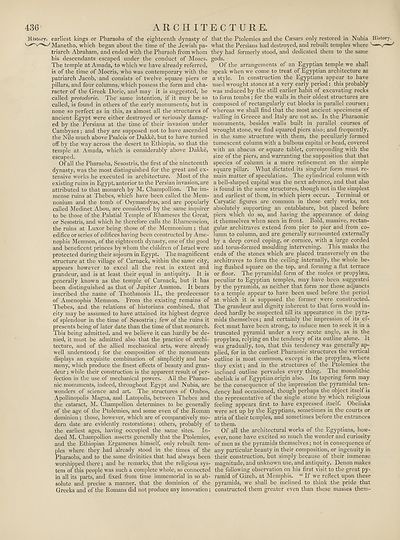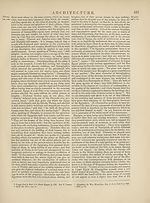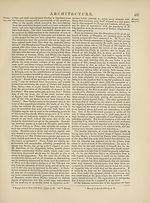Encyclopaedia Britannica > Volume 3, Anatomy-Astronomy
(444) Page 436
Download files
Complete book:
Individual page:
Thumbnail gallery: Grid view | List view

436
ARCHITECTURE.
History, earliest kings or Pharaohs of the eighteenth dynasty of that the Ptolemies and the Caesars only restored in Nubia History.
Manetho, which began about the time of the Jewish pa- what the Persians had destroyed, and rebuilt temples where v'—
triarch Abraham, and ended with the Pharaoh from whom they had formerly stood, and dedicated them to the same
his descendants escaped under the conduct of Moses, gods.
The temple at Amada, to which we have already referred, Of the arrangements of an Egyptian temple we shall
is of the time of Moeris, who was contemporary with the speak when we come to treat of Egyptian architecture as
patriarch Jacob, and consists of twelve square piers or a style. In construction the Egyptians appear to have
pillars, and four columns, which possess the form and cha
racter of the Greek Doric, and may it is suggested, be
called protodoric. The same intention, if it may be so
called, is found in others of the early monuments, but in
none so perfect as in this, as almost all the structures of
ancient Egypt were either destroyed or seriously damag¬
ed by the Persians at the time of their invasion under
Cambyses; and they are supposed not to have ascended
the Nile much above Psalcis or Dakke, but to have turned
off’ by the way across the desert to Ethiopia, so that the
temple at Amada, which is considerably above Dakke,
escaped.
Of all the Pharaohs, Sesostris, the first of the nineteenth
used wrought stones at a very early period: this probably
was induced by the still earlier habit of excavating rocks
to form tombs; for the walls in their oldest structures are
composed of rectangularly cut blocks in parallel courses;
whereas we shall find that the most ancient specimens of
walling in Greece and Italy are not so. In the Pharaonic
monuments, besides walls built in parallel courses of
wrought stone, we find squared piers also; and frequently,
in the same structure with them, the peculiarly formed
tumescent column with a bulbous capital or head, covered
with an abacus or square tablet, corresponding with the
size of the piers, and warranting the supposition that that
species of column is a mere refinement on the simple
dynasty, was the most distinguished for the great and ex- square pillar. What dictated its singular form must re-
tensive works he executed in architecture. Most of the main matter of speculation. The cylindrical column with
existing ruins in Egypt, anterior to the Persian invasion, are a bell-shaped capital was the next advance, and that also
attributed to that monarch by M. Champollion. The im- is found in the same structures, though not in the simplest
mense ruins at Thebes, which have been called the Mem- and earliest of them, in which piers occur. Terminal or
nonium and the tomb of Osymandyas, and are popularly Caryatic figures are common in those early works, not
called Medinet Abou, are considered by the same inquirer absolutely supporting an entablature, but placed before
to be those of the Palatial Temple of Rhameses the Great, piers which do so, and having the appearance of doing
or Sesostris, and which he therefore calls the Rhamesseion, it themselves when seen in front Bold, massive, rectan-
the ruins at Luxor being those of the Memnonium; that gular architraves extend from pier to pier and from co¬
edifice or series of edifices having been constructed by Ame- lumn to column, and are generally surmounted externally
nophis Memnon, of the eighteenth dynasty, one of the good by a deep coved coping, or cornice, with a large corded
and beneficent princes by whom the children of Israel were and torus-formed moulding intervening. I his masks the
protected during their sojourn in Egypt. The magnificent
structure at the village of Carnack, within the same city,
appears however to excel all the rest in extent and
grandeur, and is at least their equal in antiquity. It is
ends of the stones which are placed transversely on the
architraves to form the ceiling internally, the whole be¬
ing flushed square on the top, and forming a flat terrace
or floor. The pyramidal form of the moles or propylaea,
generally known as the temple of Carnack, but it has peculiar to Egyptian temples, may have been suggested
been distinguished as that of Jupiter Ammon. It bears by the pyramids, as neither that form nor those adjuncts
inscribed the name of Thothmosis II., the predecessor to a temple appear to have been used before the period
of Amenophis Memnon. From the existing remains of at which it is supposed the former were constructed.
Thebes, and the relations of historians combined, that The grandeur and dignity inherent to that form would in¬
city may be assumed to have attained its highest degree deed hardly be suspected till its appearance in the pyra-
of splendour in the time of Sesostris; few of the ruins it mids themselves; and certainly the impression of its ef-
presents being of later date than the time of that monarch, feet must have been strong, to induce men to seek it in a
This being admitted, and we believe it can hardly be de- truncated pyramid under a very acute angle, as in the
nied, it must be admitted also that the practice of archi- propylaea, relying on the tendency of its outline alone. It
tecture, and of the allied mechanical arts, were already was gradually, too, that this tendency was generally ap-
well understood; for the composition of the monuments plied, for in the earliest Pharaonic structures the vertical
displays an exquisite combination of simplicitly and har- outline is most common, except in the propylaea, where
mony, which produce the finest effects of beauty and gran- they exist; and in the structures of the Ptolemies the
deur; while their construction is the apparent result of per- inclined outline pervades everything. rIhe monolithic
fection in the use of mechanical powers. Ail the Pharao- obelisk is of Egyptian origin also. Its tapering form may
nic monuments, indeed, throughout Egypt and Nubia, are be the consequence of the impression the pyramidal ten-
wenders of science and art. The structures of Ombos, dency had occasioned, though perhaps the object itself is
Apollinopolis Magna, and Latopolis, between Thebes and the representative of the single stone by which religious
the cataract, M. Champoliion determines to be generally feeling appears first to have expressed itself. Obelisks
of the age of the Ptolemies, and some even of the Roman were set up by the Egyptians, sometimes in the courts or
dominion ; those, however, which are of comparatively mo- atria of their temples, and sometimes before the entrances
dern date are evidently restorations; others, probably of to them.
the earliest ages, having occupied the same sites. In- Of all the architectural works of the Egyptians, how-
deed M. Champollion asserts generally that the Ptolemies, ever, none have excited so much the wonder and curiosity
and the Ethiopian Ergamenes himself, only rebuilt tern- of men as the pyramids themselves ; not in consequence of
pies where they had already stood in the times of the any particular beauty in their composition, or ingenuity in
Pharaohs, and to the same divinities that had always been their construction, but simply because of their immense
worshipped there ; and he remarks, that the religious sys- magnitude, and unknown use, and antiquity. Denon makes
tem of this people was such a complete whole, so connected the following observation on his first visit to the great py-
in all its parts, and fixed from time immemorial in so ab- ramid of Gizeh, at Memphis. “ If we reflect upon these
solute and precise a manner, that the dominion of the pyramids, we shall be inclined to think the pride that
Greeks and of the Romans did not produce any innovation; constructed them greater even than these masses them-
ARCHITECTURE.
History, earliest kings or Pharaohs of the eighteenth dynasty of that the Ptolemies and the Caesars only restored in Nubia History.
Manetho, which began about the time of the Jewish pa- what the Persians had destroyed, and rebuilt temples where v'—
triarch Abraham, and ended with the Pharaoh from whom they had formerly stood, and dedicated them to the same
his descendants escaped under the conduct of Moses, gods.
The temple at Amada, to which we have already referred, Of the arrangements of an Egyptian temple we shall
is of the time of Moeris, who was contemporary with the speak when we come to treat of Egyptian architecture as
patriarch Jacob, and consists of twelve square piers or a style. In construction the Egyptians appear to have
pillars, and four columns, which possess the form and cha
racter of the Greek Doric, and may it is suggested, be
called protodoric. The same intention, if it may be so
called, is found in others of the early monuments, but in
none so perfect as in this, as almost all the structures of
ancient Egypt were either destroyed or seriously damag¬
ed by the Persians at the time of their invasion under
Cambyses; and they are supposed not to have ascended
the Nile much above Psalcis or Dakke, but to have turned
off’ by the way across the desert to Ethiopia, so that the
temple at Amada, which is considerably above Dakke,
escaped.
Of all the Pharaohs, Sesostris, the first of the nineteenth
used wrought stones at a very early period: this probably
was induced by the still earlier habit of excavating rocks
to form tombs; for the walls in their oldest structures are
composed of rectangularly cut blocks in parallel courses;
whereas we shall find that the most ancient specimens of
walling in Greece and Italy are not so. In the Pharaonic
monuments, besides walls built in parallel courses of
wrought stone, we find squared piers also; and frequently,
in the same structure with them, the peculiarly formed
tumescent column with a bulbous capital or head, covered
with an abacus or square tablet, corresponding with the
size of the piers, and warranting the supposition that that
species of column is a mere refinement on the simple
dynasty, was the most distinguished for the great and ex- square pillar. What dictated its singular form must re-
tensive works he executed in architecture. Most of the main matter of speculation. The cylindrical column with
existing ruins in Egypt, anterior to the Persian invasion, are a bell-shaped capital was the next advance, and that also
attributed to that monarch by M. Champollion. The im- is found in the same structures, though not in the simplest
mense ruins at Thebes, which have been called the Mem- and earliest of them, in which piers occur. Terminal or
nonium and the tomb of Osymandyas, and are popularly Caryatic figures are common in those early works, not
called Medinet Abou, are considered by the same inquirer absolutely supporting an entablature, but placed before
to be those of the Palatial Temple of Rhameses the Great, piers which do so, and having the appearance of doing
or Sesostris, and which he therefore calls the Rhamesseion, it themselves when seen in front Bold, massive, rectan-
the ruins at Luxor being those of the Memnonium; that gular architraves extend from pier to pier and from co¬
edifice or series of edifices having been constructed by Ame- lumn to column, and are generally surmounted externally
nophis Memnon, of the eighteenth dynasty, one of the good by a deep coved coping, or cornice, with a large corded
and beneficent princes by whom the children of Israel were and torus-formed moulding intervening. I his masks the
protected during their sojourn in Egypt. The magnificent
structure at the village of Carnack, within the same city,
appears however to excel all the rest in extent and
grandeur, and is at least their equal in antiquity. It is
ends of the stones which are placed transversely on the
architraves to form the ceiling internally, the whole be¬
ing flushed square on the top, and forming a flat terrace
or floor. The pyramidal form of the moles or propylaea,
generally known as the temple of Carnack, but it has peculiar to Egyptian temples, may have been suggested
been distinguished as that of Jupiter Ammon. It bears by the pyramids, as neither that form nor those adjuncts
inscribed the name of Thothmosis II., the predecessor to a temple appear to have been used before the period
of Amenophis Memnon. From the existing remains of at which it is supposed the former were constructed.
Thebes, and the relations of historians combined, that The grandeur and dignity inherent to that form would in¬
city may be assumed to have attained its highest degree deed hardly be suspected till its appearance in the pyra-
of splendour in the time of Sesostris; few of the ruins it mids themselves; and certainly the impression of its ef-
presents being of later date than the time of that monarch, feet must have been strong, to induce men to seek it in a
This being admitted, and we believe it can hardly be de- truncated pyramid under a very acute angle, as in the
nied, it must be admitted also that the practice of archi- propylaea, relying on the tendency of its outline alone. It
tecture, and of the allied mechanical arts, were already was gradually, too, that this tendency was generally ap-
well understood; for the composition of the monuments plied, for in the earliest Pharaonic structures the vertical
displays an exquisite combination of simplicitly and har- outline is most common, except in the propylaea, where
mony, which produce the finest effects of beauty and gran- they exist; and in the structures of the Ptolemies the
deur; while their construction is the apparent result of per- inclined outline pervades everything. rIhe monolithic
fection in the use of mechanical powers. Ail the Pharao- obelisk is of Egyptian origin also. Its tapering form may
nic monuments, indeed, throughout Egypt and Nubia, are be the consequence of the impression the pyramidal ten-
wenders of science and art. The structures of Ombos, dency had occasioned, though perhaps the object itself is
Apollinopolis Magna, and Latopolis, between Thebes and the representative of the single stone by which religious
the cataract, M. Champoliion determines to be generally feeling appears first to have expressed itself. Obelisks
of the age of the Ptolemies, and some even of the Roman were set up by the Egyptians, sometimes in the courts or
dominion ; those, however, which are of comparatively mo- atria of their temples, and sometimes before the entrances
dern date are evidently restorations; others, probably of to them.
the earliest ages, having occupied the same sites. In- Of all the architectural works of the Egyptians, how-
deed M. Champollion asserts generally that the Ptolemies, ever, none have excited so much the wonder and curiosity
and the Ethiopian Ergamenes himself, only rebuilt tern- of men as the pyramids themselves ; not in consequence of
pies where they had already stood in the times of the any particular beauty in their composition, or ingenuity in
Pharaohs, and to the same divinities that had always been their construction, but simply because of their immense
worshipped there ; and he remarks, that the religious sys- magnitude, and unknown use, and antiquity. Denon makes
tem of this people was such a complete whole, so connected the following observation on his first visit to the great py-
in all its parts, and fixed from time immemorial in so ab- ramid of Gizeh, at Memphis. “ If we reflect upon these
solute and precise a manner, that the dominion of the pyramids, we shall be inclined to think the pride that
Greeks and of the Romans did not produce any innovation; constructed them greater even than these masses them-
Set display mode to:
![]() Universal Viewer |
Universal Viewer | ![]() Mirador |
Large image | Transcription
Mirador |
Large image | Transcription
Images and transcriptions on this page, including medium image downloads, may be used under the Creative Commons Attribution 4.0 International Licence unless otherwise stated. ![]()
| Encyclopaedia Britannica > Encyclopaedia Britannica > Volume 3, Anatomy-Astronomy > (444) Page 436 |
|---|
| Permanent URL | https://digital.nls.uk/193763120 |
|---|
| Attribution and copyright: |
|
|---|---|
| Shelfmark | EB.16 |
|---|---|
| Description | Ten editions of 'Encyclopaedia Britannica', issued from 1768-1903, in 231 volumes. Originally issued in 100 weekly parts (3 volumes) between 1768 and 1771 by publishers: Colin Macfarquhar and Andrew Bell (Edinburgh); editor: William Smellie: engraver: Andrew Bell. Expanded editions in the 19th century featured more volumes and contributions from leading experts in their fields. Managed and published in Edinburgh up to the 9th edition (25 volumes, from 1875-1889); the 10th edition (1902-1903) re-issued the 9th edition, with 11 supplementary volumes. |
|---|---|
| Additional NLS resources: |
|

